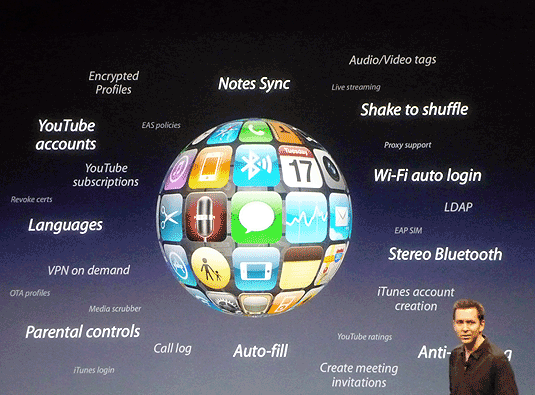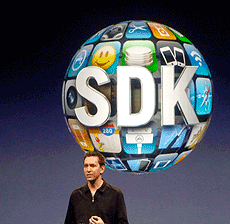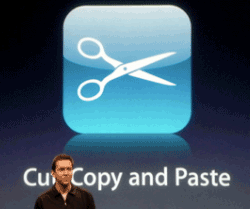 First, an apology. The gods of technology usually treat me pretty well, but they chose this morning to punish me, presumably for some tech-related crime I’d committed (possibly insufficient backing up). My liveblogging failed to come off as planned, and if you showed up and were disappointed, I’m sorry (and thanks to Ed Oswald for helping to deal with the situation) .
First, an apology. The gods of technology usually treat me pretty well, but they chose this morning to punish me, presumably for some tech-related crime I’d committed (possibly insufficient backing up). My liveblogging failed to come off as planned, and if you showed up and were disappointed, I’m sorry (and thanks to Ed Oswald for helping to deal with the situation) .
Eventually, I realized that Twitter on my iPhone could serve as a respectable alternative mode of communication. And I guess it’s appropriate that I used my iPhone to relay information about the next generation of iPhone software.
The good news? Well, actually, the whole darn event was good stuff other than my technical woes: iPhone 3.0 looks really, really promising. I’ll have a lot more to say about it in the coming hours, days, weeks, and months, but for now, I wanted to recap my wish list from a few hours ago and see how Apple did at addressing my hopes, dreams, and ambitions.
Here’s what I was wishing for…and whether it came up in today’s announcements.
1) More TLC for iPhone developers. Like clearer policies, fast-tracking through the approval process, and measures that will give companies incentive to build more ambitious apps that are worth more than $2.99. [How’d Apple do? It didn’t do any of this stuff, specifically, but it introduced numerous things that should please iPhone software creators: subscription plans in the iPhone App Store, the ability to embed maps, the ability to talk to hardware, the ability to support cut and paste…and it said that it wants to work really hard to make getting apps distributed fast and easy. Overall, good news.]
2) Tools for managing a ton of apps. Like the ability to name groups of icons (Games, Communications, Productivity) and jump between them directly rather than having to side-swipe until you get to the page you want. You know, sort of what like you could do on a PalmPilot a decade ago. [How’d Apple do? It didn’t say anything about adding groups. But it did introduce system-wide search, including for apps, in the form of Spotlight, which should help a lot.]
3) Similarly, some sort of shortcut feature. How about a gesture that pulls up a dock of apps you’ve selected without making you go back to the home screen? [How’d Apple do? Didn’t do this, as far as we know.]
4) More speed. For all the wonderful fluidity and responsiveness of most of the iPhone experience, the OS still grinds to a halt in certain circumstances, especially when you open some apps, such as SMS. [How’d Apple do? In response to a question from the audience, we heard that 3.0 will have a variety of performance-related tweaks.]
5) More reliability. Safari still closes without warning on my iPhone from time to time. And the whole darn OS has been known to reboot itself, like a tiny Blue Screen of Death. [How’d Apple do? No news came up on this front, but I remain hopeful…]
6) Task synching. Pretty please? [How’d Apple do? Um, what if I asked again: pretty please with sugar on it?]
7) Notes synching. With a more powerful and straightforward notes app (I’d love to kill the lined yellow paper interface and funky font). [How’d Apple do? Done! Maybe not the font part, but Notes now allows synching, has cut and paste, and works in landscape mode.]
8) The notification service that Apple promised last June. So apps such as instant messengers have some ability to work in the background. I’d love something far closer to true multitasking if Apple could figure out how to do it without making the phone less reliable, but I’ll take what I can get. [How’d Apple do? Done! Notifications should be a huge boon. We saw a demo of the Meebo universal IM service with IMs working even when you weren’t in the app, and it looked terrific.]
9) An option that lets you choose a delay before the phone’s auto-lock feature kicks in. So I don’t have to do the slide-and-unlock gesture every time I turn the phone on. [How’d Apple do? This didn’t come up, but it’s minor enough that I suppose it could be one of the 100 new features that went unmentioned, of which there were presumably quite a few.]
10) The ability for third-party apps to get at file attachments from e-mail. So it’s easier to use productivity apps such as the spreadsheet in QuckOffice’s Mobilefiles Pro. [How’d Apple do? This wasn’t mentioned specifically, but there are apparently some enhancements relating to e-mail/third-party app integration.]
11) Tethering. It’s been four months since AT&T told us it was coming soon; the clock is starting to run out on “soon.” [How’d Apple do? iPhone 3.0 has tethering support, but carriers, including AT&T, will need to decide when and how to support it. Wonder if this means we won’t see it until the new software shows up this summer?]
12) Input-output stuff that would permit more iPhone-specific hardware accessories. I want a Think Outside keyboard for my iPhone, darn it! [How’d Apple do? It added support for peripherals via the dock connector and Bluetooth. But not, as far as I can tell, for keyboards, which would require software glue to communicate with applications that involve alphanumeric input. Dang.]
13) iLife for the iPhone. Or at least the start of an iLife-like suite of creativity apps that take advantage of the phone’s hardware capabilities. I’d like to see a little photo editor, video capture and editing, and audio recording, for instance. [How’d Apple do? No news on this front.]
14) Caching in Safari. So it doesn’t want to reload pages it loaded minutes ago all over again. [How’d Apple do? No news on this front.]
15) Cut and paste. Not because I need them all that much–I think there have only been a couple of instances when I really, really felt their absence. But I’ll be glad when we can all stop wasting brain cells talking about the fact the iPhone doesn’t have them. [How’d Apple do? Done! And done well, judging from the demo.]
That’s not a bad score overall. More encouraging still, Apple added a ton of stuff I wasn’t expecting. More thoughts about all of it soon.


 Call it the
Call it the  iPhone users have groaned and moaned about the device’s lack of basic copy-and-paste functionality, but Apple held off on
iPhone users have groaned and moaned about the device’s lack of basic copy-and-paste functionality, but Apple held off on  First, an apology. The gods of technology usually treat me pretty well, but they chose this morning to punish me, presumably for some tech-related crime I’d committed (possibly insufficient backing up). My liveblogging failed to come off as planned, and if you showed up and were disappointed, I’m sorry (and thanks to Ed Oswald for helping to deal with the situation) .
First, an apology. The gods of technology usually treat me pretty well, but they chose this morning to punish me, presumably for some tech-related crime I’d committed (possibly insufficient backing up). My liveblogging failed to come off as planned, and if you showed up and were disappointed, I’m sorry (and thanks to Ed Oswald for helping to deal with the situation) .
 I’m having a very good time at the
I’m having a very good time at the